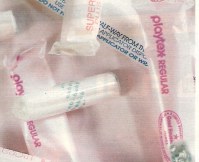Tampons By Debra Kent
|
||
 Throughout history, women have used absorbent material of one kind or another to collect menstrual flow internally, whether rolled-up grass, cloth, or the compressed cotton and rayon found in modern tampons. Today's products are just a lot more convenient than the early versions. Some brands have cardboard or plastic applicators to help slide the tampon into place (like Tampax and Playtex). With others you simply use a finger to push the tampon in (like o.b.). All have a string at one end for pulling the tampon out.
We know from research on our readers that about 66 percent of you currently use tampons during your period, and 74 percent of you use sanitary napkins. Forty percent use a combination of both methods.
Starting to menstruate can be exciting, but it can also be a little overwhelming. Most girls aren't quite ready to figure out tampons just then. Almost all the readers surveyed used sanitary napkins during their first few periods, then began using tampons later on.
Tampons have several advantages. Inserted correctly and changed regularly, tampons are comfortable (to the point that it's possible to forget you're wearing one) and don't interfere with daily activities. And because a tampon is worn internally, the menstrual flow is not exposed to air, which means that it doesn't develop the stale odor sometimes associated with napkins.
I've tried using tampons, but I can't get them in and they hurt. I get so sore trying to put them in. I'm about to start a job as a lifeguard, and I'll have to wear them. What can I do?
The first step is to relax. I know it's not easy to do that when you're nervous about trying something for the first time, but if you're tense, it can cause your vaginal opening to tighten up, making it difficult or even impossible (for the moment) to slide a tampon in. The vaginal opening and vaginal canal are very elastic; after all, they're designed to stretch wide enough to accommodate a baby, so they can certainly handle a tampon. Even so, lots of girls have trouble the first few times. In addition to the general instructions that are included with every box of tampons, these tips may help:
. Start with the smaIIest, slimmest size available, sometimes called "slender" or "junior. "
. Some people put saliva or a water-soluble lubricant, like K- Y jelly, on the tip of the tampon or applicator to make it easier to slide in. Don't use a moisturizer or lotion to lubricate the tampon, since these products of ten contain chemicals that can irritate you and make you more vulnerable to infection. Vaseline isn't watersoluble and won't wash off easily, so it's not a good lubricant, either.
· Gently spread your vaginal lips apart with your fingers for access to the vaginal opening.
· Try taking a deep breath, then begin inserting the tampon while you slowly exhale.
· If it has an applicator, practice pushing the tampon out with the plunger so you can see how it works. Put your forefinger on the tip of the plunger (where the string is), and use your other fingers to grasp the other section of the applicator. The idea is to slide the tampon applicator partway inside your vagina, then push the plunger up into the applicator, which pushes the tampon into your vagina. This may sound complicated, but with a little practice it will be easy and feel natural.
. Insert the tampon at an angle toward your back; pushing it straight up makes it harder to insert and is uncomfortable. As you can see by the illustration in the instructions that come with the box, the vagina is angled back. If you' ve put the tampon in correctly, you shouldn't feel it at all. If it's uncomfortable, it's probably not in far enough or at the wrong angle.
If you've tried all these techniques several times and you're still having problems getting the tampon in, see a gynecologist. You may have some obstructive hymenal tissue (the thin membrane that may partially cover the vaginal opening in some girls), which can make inserting a tampon more difficult. You may also have a vaginal infection, which could explain the soreness you describe (by the way, you don't have to be sexually active to develop a vaginal infection).
Source: Seventeen Magazine
|
Using Tampons
|
|